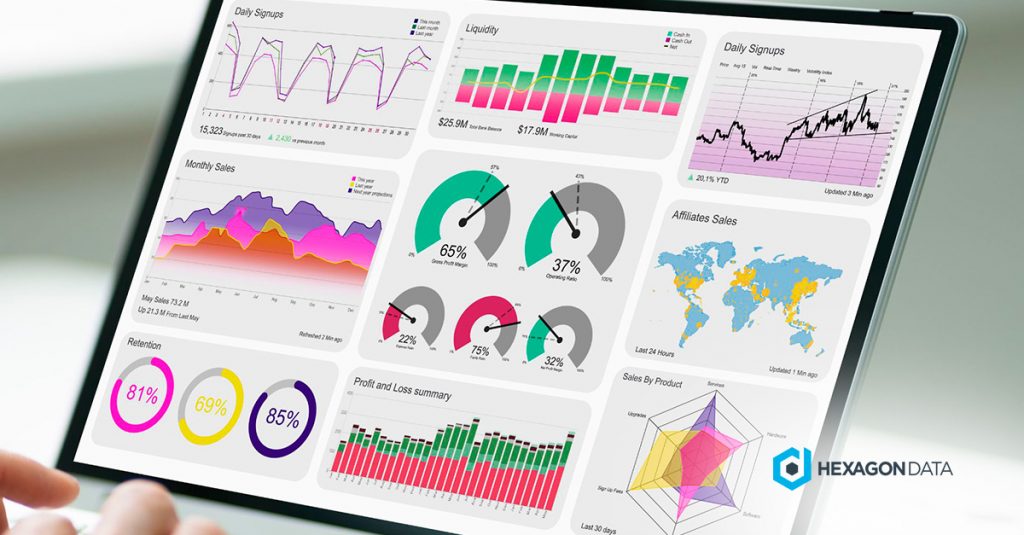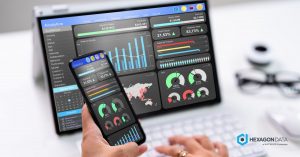|
Listen to the Article
|
In today’s data-driven world, businesses and marketers are constantly seeking ways to effectively communicate complex information and insights to their target audience. One powerful tool that has emerged to meet this demand is interactive data visualizations. By combining the art of design with the science of data analysis, interactive data visualizations offer a dynamic and engaging way to present information, enabling users to explore, interpret, and derive meaning from vast datasets.
In this article, we will delve into the art and science behind designing interactive data visualizations that captivate and inform. We will explore the importance of choosing the right visualization techniques, discuss the role of interactive elements in enhancing user engagement, and examine the fundamental design principles that contribute to the effectiveness of data visualizations. Whether you are a marketer looking to convey complex insights to clients, a data analyst aiming to communicate findings to a wider audience, or a designer seeking to create visually compelling experiences, this article will provide valuable insights and practical tips to help you design interactive data visualizations that leave a lasting impact.
So, if you are ready to unlock the potential of data storytelling and captivate your audience through visually immersive experiences, let us dive into the world of interactive data visualizations and discover the keys to creating compelling and meaningful visual narratives.
Choosing the Right Visualization Techniques
When it comes to designing interactive data visualizations, one of the crucial decisions you need to make is selecting the appropriate visualization technique that best suits your data. Diverse types of data require different methods of representation to effectively communicate their underlying patterns, trends, and relationships. Let us explore some key considerations and steps to help you choose the right visualization technique for your data.
- Understanding Your Data: Before diving into visualization options, it is essential to have a deep understanding of your data. Start by examining its nature, structure, and the insights you want to convey. Is your data categorical or numerical? Are you analyzing trends over time or comparing various categories? By identifying the core characteristics and goals of your data, you can narrow down the visualization techniques that will be most effective.
- Exploring Visualization Types: The world of data visualization offers a diverse range of techniques, each with its strengths and limitations. Familiarize yourself with common visualization types such as bar charts, line graphs, scatter plots, pie charts, heatmaps, and more. Understand how each technique represents several types of data and which types of insights they excel at conveying. This exploration will provide you with a toolbox of options to choose from when designing your interactive visualization.
- Matching Visualization Techniques to Data Attributes: Once you have a clear understanding of your data and have explored various visualization techniques, it is time to match the attributes of your data to the appropriate visualization types. For example, if you want to compare the distribution of a categorical variable, a bar chart might be suitable. On the other hand, if you are examining the relationship between two continuous variables, a scatter plot or line graph might be more appropriate. Consider the nature of your data, the patterns you want to emphasize, and the message you want to convey when selecting the visualization technique.

If you are interested in visualization, you can go further in: The 6 Visualization Tools for Powering Your Marketing Data
Remember, the goal is to choose a visualization technique that not only accurately represents your data but also engages and informs your audience. A well-selected visualization technique will make it easier for users to grasp insights and draw meaningful conclusions from the data. By understanding your data, exploring visualization options, and matching techniques to data attributes, you can lay a solid foundation for creating impactful interactive data visualizations.
Enhancing User Engagement with Interactive Elements
Designing interactive data visualizations goes beyond creating static charts and graphs. It involves incorporating interactive elements that empower users to actively engage with the data, explore different perspectives, and derive insights through hands-on interaction. Let us delve into the key considerations and techniques for enhancing user engagement with interactive elements in your data visualizations.
- Intuitive User Interface Design: A well-designed user interface (UI) is critical for providing a seamless and intuitive experience. Consider the layout, navigation, and overall visual design of your visualization. Aim for simplicity and clarity, ensuring that users can easily understand how to interact with the visualization. Use clear labels, intuitive icons, and visual cues to guide users through the interactive elements.
- Incorporating Filters and Controls: Filters and controls allow users to dynamically manipulate the displayed data, enabling them to focus on specific subsets or explore different dimensions. Implement interactive filters, sliders, drop-down menus, or checkboxes to give users control over the data they want to analyze. This flexibility allows users to customize their experience and delve deeper into the insights that matter to them.
- Interactive Tooltips and Pop-ups: Tooltips and pop-ups provide contextual information when users interact with specific data points or elements. By hovering over a data point or clicking on an element, users can access additional details or explanatory text. This interactive feature enhances comprehension and enables users to explore the nuances of the data without cluttering the main visualization.
- Animations and Transitions: Animations and transitions can be used strategically to guide users’ attention and highlight changes in the data. Consider animating the transition between different states or time periods, emphasizing key insights, or highlighting the relationships between data points. Thoughtful use of animations can create a visually engaging experience and make the storytelling process more captivating.
- Responsive Design for Multiple Devices: With the increasing use of mobile devices and varying screen sizes, it is crucial to ensure that your interactive visualizations are responsive and adaptable to different platforms. Optimize the design for mobile devices, tablets, and desktops, providing an optimal viewing and interaction experience across all screen sizes.
By incorporating intuitive user interface design, interactive filters and controls, tooltips, animations, and responsive design, you can create immersive and engaging experiences that empower users to interact with your data visualizations. The interactive elements not only increase user engagement but also enable users to discover insights, gain a deeper understanding, and make data-driven decisions.
Design Principles for Effective Data Visualizations
Design plays a crucial role in creating effective data visualizations that convey information clearly and engage the audience. By applying fundamental design principles, you can transform raw data into visually compelling and meaningful representations. Let’s explore some key design principles to consider when crafting your interactive data visualizations.
- Visual Hierarchy and Information Design: Establishing a clear visual hierarchy helps users quickly understand the importance and relationships of different elements within the visualization. Use visual cues such as size, color, and position to convey the relative significance of data points or categories. Group related information together and ensure that the most important insights are easily discernible at first glance.
- Color and Typography: Thoughtful use of color and typography can greatly enhance the aesthetics and legibility of your data visualizations. Choose a color palette that not only looks visually appealing but also aids in conveying meaning. Use color strategically to represent different categories or highlight specific data points. Similarly, select appropriate fonts and font sizes that ensure readability across different devices.
- Clarity and Simplicity: Strive for simplicity and avoid clutter in your visualizations. Remove unnecessary elements that may distract or confuse the audience. Keep labels concise and use clear and descriptive titles. Use whitespace effectively to provide visual breathing room and guide users’ focus towards the most important aspects of the visualization.
- Consistency and Repetition: Consistency, in visual elements such as colors, fonts, icons, and styles, helps establish a sense of coherence throughout the visualization. Maintain consistency across different charts or graphs within the same project to ensure a unified visual experience. Repetition of design elements can reinforce patterns and help users make connections across different sections of the visualization.
- Contextualize the Data: Provide relevant context and annotations to help users interpret the data accurately. Use captions, headings, or explanatory text to provide background information or key insights. Incorporate axis labels, legends, and units of measurement to ensure data is understood within the appropriate context. Contextualizing the data fosters a deeper understanding and prevents misinterpretation.

If you are interested in data visualization, you can go further in: How to take your data visualization game to the next level
By adhering to these design principles, you can create visually appealing and meaningful data visualizations that effectively communicate insights. Remember that design choices should always serve the purpose of enhancing understanding and engagement with the data, allowing users to extract valuable information and make informed decisions.
Conclusion: Harnessing the Power of Interactive Data Visualizations
Interactive data visualizations have emerged as a powerful tool for marketers, data analysts, and designers to convey complex information in a captivating and meaningful way. By choosing the right visualization techniques, incorporating interactive elements, and applying fundamental design principles, you can create immersive experiences that engage and inform your audience.
The benefits of interactive data visualizations are manifold. They enable users to explore data from multiple angles, derive insights through hands-on interaction, and uncover hidden patterns or trends. Interactive elements such as filters, tooltips, and animations empower users to customize their experience, delve deeper into the data, and gain a deeper understanding of the subject matter. These visual narratives have the potential to spark curiosity, facilitate data-driven decision-making, and communicate complex concepts more effectively than traditional static representations.
As you embark on designing your own interactive data visualizations, keep in mind the key takeaways from this article. Choose visualization techniques that align with your data attributes and goals. Incorporate intuitive user interfaces, interactive filters, and tooltips to enhance engagement and exploration. Adhere to design principles such as visual hierarchy, simplicity, and consistency to create visually appealing and informative visualizations. And always provide relevant context and annotations to ensure accurate interpretation of the data.
In the dynamic landscape of marketing and data analysis, interactive data visualizations have become essential tools for effectively communicating insights and engaging audiences. Embrace the potential of interactive data visualizations to captivate your audience, uncover meaningful insights, and make data-driven decisions. By harnessing the power of interactive data visualizations, you can transform raw data into compelling narratives that leave a lasting impact.
So, go ahead, unleash your creativity, and design interactive data visualizations that tell stories, inspire action, and drive meaningful change. Your audience awaits the immersive experiences that await them within the realm of data visualization.




